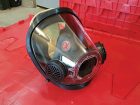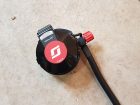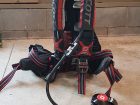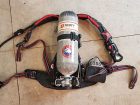
Features
Structural
Training
Back to Basics: June 2019
In our last issue, we looked at the PASS alarm and the important role that it plays on the fire ground and to the user. We examined the common occurrences for PASS alarms to go off on the fire ground and why they are a danger to the user and those that hear it.
May 15, 2019
By Mark van der Feyst
The PASS alarm is attached to, and a part of the SCBA, which is what we are going to examine in this issue – the dangers of not wearing or using the SCBA, or self-contained breathing apparatus.
The SCBA is the most advanced and intricate piece of personal protective equipment that we have and use to protect ourselves against the environment that we face. Our job takes us to many playgrounds with varying types of environments, such as inside structures where there is fire and toxic products of combustion and elevated temperatures, inside structures for non-structure fire calls where the environment is toxic for other reasons, outside at vehicle accidents, vehicle fires, hazmat calls, certain industrial facilities and so on.
The environment that we need protection from is toxic and not adequate to support life – it is immediate danger to life and health. The SCBA came into existence after the Second World War based upon aviation systems used for the protection of pilots when they were flying. After the war, the system was adapted to protect firefighters from the dangers of smoke and elevated temperatures. From that time until today, the SCBA has been transformed into a technological marvel, offering the highest respiratory protection any one person can receive.
So how exactly does the SCBA protect us? It protects the biggest and easiest-compromised system in our body; the respiratory system. Just think about it, one breath from a toxic environment can kill us and we can not even see what we are breathing in. Therefore, every firefighter needs to wear and use his or her SCBA at all times when he or she is exposed to any abnormal working environment. There is no excuse good enough to justify not wearing the SCBA – even though some firefighters still try to excuse themselves from doing so.
The SCBA is comprised of four parts: regulator; cylinder; backplate and harness; and facepiece. No matter what brand of SCBA you are using, they all have these four basic components. Let’s look at each one to detail how well they will protect you when wearing it.
The facepiece protects the user’s face and mouth and doubles as a connection point for the regulator as well as impact protection for the face with the lens.
With the current NFPA standard (2013) for SCBA, the lens of the facepiece has to be able to withstand higher heat temperatures (above 500 degrees F) when exposed to them. The previous versions of the facepieces had a lower temperature rating (under 500 degrees F) which made it the weakest link or piece of the SCBA and PPE ensemble.
The special coatings on the lens allows for more heat absorption and heat sink which protects the user from the facepiece failing too quickly when exposed to elevated temperatures – but this can also be a detriment to the user because the heat absorbed is not able to dissipate quickly enough, causing the special coatings on the lens to break down. This is evident when inspecting the lens of the mask and noticing the marble looking cracks and waves on the lens.
The regulator is where the closed system comes into play because it attaches to the facepiece and provides a continuous flow of air to the user from the cylinder. The air flow in the regulator has been stepped down from the cylinder pressure of either 2,216 pounds per square inch (psi) or 4,500 psi to about 100 psi or less. This is a breathable amount of pressure for the user and enough to expel unwanted environmental contaminants from entering into the facepiece from a broken seal.
The regulator under the current NFPA 2013 edition has to be CBRN compliant, meaning that it will still work and function when exposed to limited amounts of radiation, chemical, biological and nuclear types of contamination.
The unique feature of the regulator is the emergency bypass valve. This is the user’s protection feature when the regulator fails to work. The user can manually open the bypass valve and still have a free flow of air provided to them for the express purpose of getting out and staying alive. This function can be either opened fully with free-flowing air occurring or it can be opened and closed intermittently to allow for more air consumption time for getting out and staying alive.
The backplate and harness is where the electronic brains of the SCBA are usually located as well as the reducing block for the cylinder air to be processed and stepped down for the regulator.
Within the backplate will be the hoses for both high- and low-pressure systems running up and supplying the different aspects of the SCBA. These hoses will be buried within the backplate to protect them as much as possible from any entanglement hazards and cutting hazards. The previous versions of SCBA had these hoses all exposed which exposed the user to potential snag and cutting hazards.
The straps of the SCBA are also designed to provide protection for the user. They are made from a Kevlar-type of material for abrasion and cut resistance which allows the user to not have to worry about the straps coming apart from the backplate when exposed to those hazards. Most straps will also have reflective material added to the front of them to provide more visibility at nighttime or when a light is shone upon them.
The cylinder sits in the backplate and harness. Most SCBA cylinders being used now are carbon fiber, except for some departments still using aluminum. Regardless of the type of cylinder being used, it is designed to keep the air that is inside the cylinder inside the cylinder. The cylinder is under extreme pressure: 2,216; 4,500; or 5,500 psi and has to be released through a small air tube inside the cylinder which then goes into the SCBA system (reducing block). The valve on the cylinder and the walls of the cylinder are constructed to withstand our working environment – which includes elevated temperatures, decreased temperatures such as freezing, coming into contact with hard objects, being dropped, and so on.
The working environment of the firefighter is harsh and the SCBA has been designed and constructed to meet those harsh demands so that it can function and provide a high level of safety and protection for the user. So, why are you not wearing it when you need to wear it?
Mark van der Feyst has been a member of the fire service since 1999 and is a full-time firefighter in Ontario. Mark teaches in Canada, United States and India, and is a FDIC instructor. He is the lead author of the Residential Fire Rescue book.
Contact Mark at Mark@FireStarTraining.com.
Print this page



